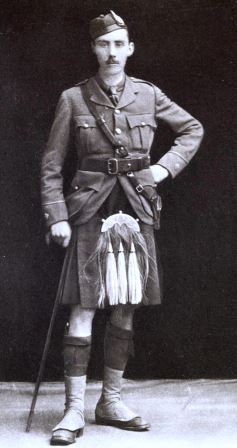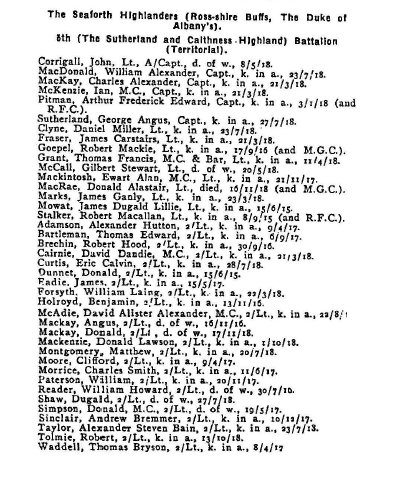
Today marks the centenary of the death on 21 November 1917 of the Scottish soldier poet Lieutenant Ewart Alan Mackintosh MC in the Battle of Cambrai.
His death is listed in ScotlandsPeople, among the Minor Records (a copy of the volume ‘Officers Died in the Great War 1914-1919’, HMSO, 1919).
Mackintosh was attached to the 1/4th Battalion, Seaforth Highlanders, and was killed in action during the attack by the 51st (Highland) Division at Flesquieres Ridge. This was part of a British assault on the Hindenburg Line east of Arras. Artillery and tanks were co-ordinated in a new way but the initial gains were reclaimed by a German counter-attack.
Alan Mackintosh was born in 1893 in England to Scottish parents and educated in England. His Scottish roots were strong, and shaped his outlook, his poetry and his military career. When he volunteered in 1914 he was rejected as short-sighted, but he persisted and obtained a commission in the Seaforth Highlanders, the regiment which recruited in Easter Ross, where his family had lived.
He trained and served with the 5th Battalion, and was familiarly known as “Tosh”. In 1915 he was posted to the Western Front where, on 16 May 1916, he led a successful trench raid and helped to rescue two of his wounded men. His conspicuous gallantry earned him the Military Cross and three of his men won the Military Medal.
However, he was forced to leave behind the mortally-wounded Private David Sutherland and soon poured his grief into one of his best-known poems, “In Memoriam”, modelled on a Gaelic lament. Sutherland’s will can be found among Sutherland’s will, and those of over 2,000 Seaforth Highlanders, 1914-1918, can be found among the Soldiers’ Wills in ScotlandsPeople.

In late July 1916 Mackintosh was injured and evacuated from the Somme battlefield, and spent months recovering before being posted to a training unit at Cambridge, where he fell in love with a nurse, Sylvia Marsh.
Nevertheless he chafed at being separated from his regiment and in September 1917 his wish to be posted to France was granted, although he went to a different battalion – the 1/4th Battalion, Seaforth Highlanders.
Alan Mackintosh’s reputation as a war poet has been overshadowed by his better-known English and Welsh comrades. His first volume, ‘A Highland Regiment’ (1917), and the posthumous ‘War, the Liberator’ (1918), have gained some recognition. The final couplet from his poem “A Creed”, which is inscribed on the Scottish American War Memorial in Princes Street Gardens, Edinburgh, will be more familiar than his name:
If it be life that waits I shall live for ever unconquered,
If death I shall die at last, strong in my pride and free.

There is a biography of Mackintosh. It’s called “Can’t shoot a man with a cold”, written by Colin Campbell and Rosalind Green and published by Argyll Publishing in 2004.
LikeLike